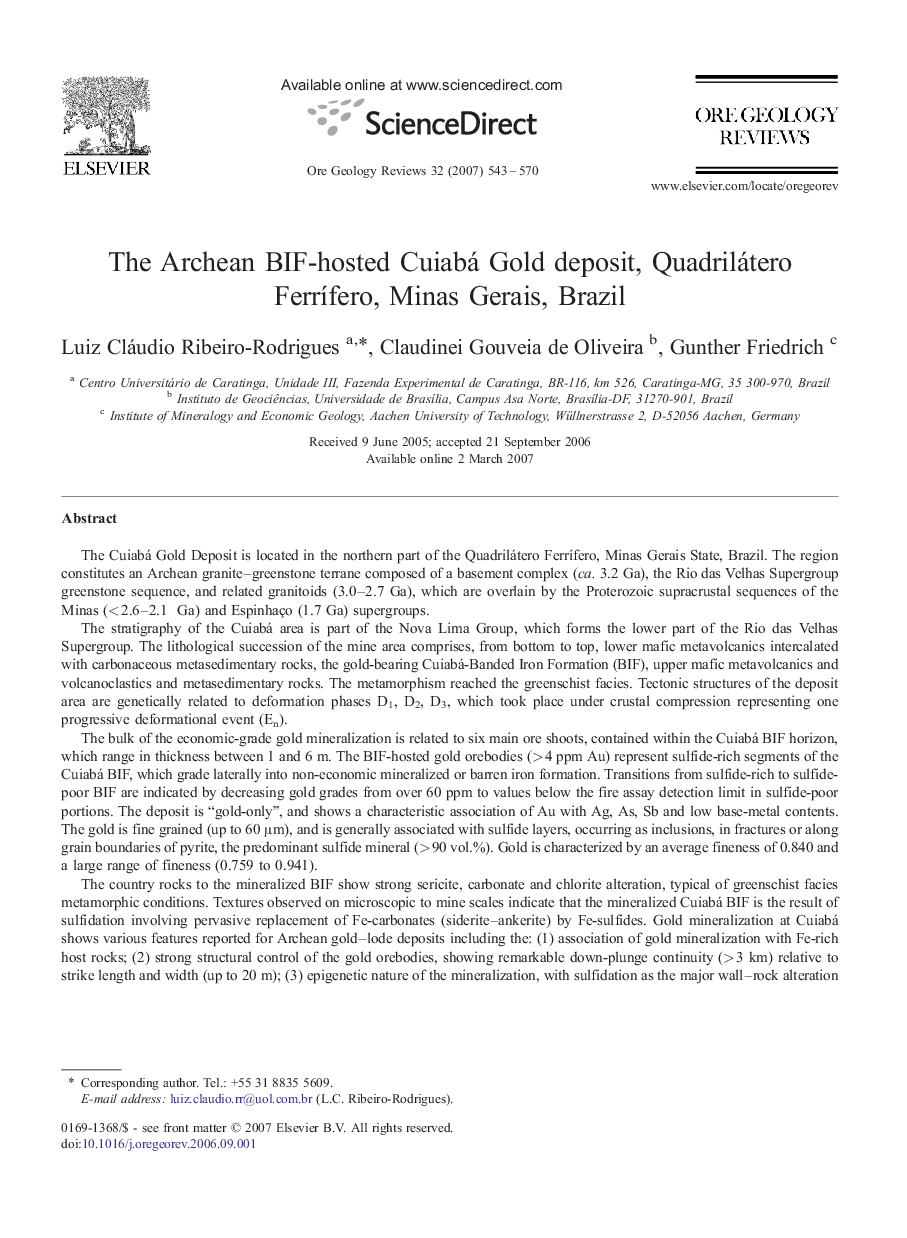| کد مقاله | کد نشریه | سال انتشار | مقاله انگلیسی | نسخه تمام متن |
|---|---|---|---|---|
| 4698112 | 1637268 | 2007 | 28 صفحه PDF | دانلود رایگان |

The Cuiabá Gold Deposit is located in the northern part of the Quadrilátero Ferrífero, Minas Gerais State, Brazil. The region constitutes an Archean granite–greenstone terrane composed of a basement complex (ca. 3.2 Ga), the Rio das Velhas Supergroup greenstone sequence, and related granitoids (3.0–2.7 Ga), which are overlain by the Proterozoic supracrustal sequences of the Minas (< 2.6–2.1 Ga) and Espinhaço (1.7 Ga) supergroups.The stratigraphy of the Cuiabá area is part of the Nova Lima Group, which forms the lower part of the Rio das Velhas Supergroup. The lithological succession of the mine area comprises, from bottom to top, lower mafic metavolcanics intercalated with carbonaceous metasedimentary rocks, the gold-bearing Cuiabá-Banded Iron Formation (BIF), upper mafic metavolcanics and volcanoclastics and metasedimentary rocks. The metamorphism reached the greenschist facies. Tectonic structures of the deposit area are genetically related to deformation phases D1, D2, D3, which took place under crustal compression representing one progressive deformational event (En).The bulk of the economic-grade gold mineralization is related to six main ore shoots, contained within the Cuiabá BIF horizon, which range in thickness between 1 and 6 m. The BIF-hosted gold orebodies (> 4 ppm Au) represent sulfide-rich segments of the Cuiabá BIF, which grade laterally into non-economic mineralized or barren iron formation. Transitions from sulfide-rich to sulfide-poor BIF are indicated by decreasing gold grades from over 60 ppm to values below the fire assay detection limit in sulfide-poor portions. The deposit is “gold-only”, and shows a characteristic association of Au with Ag, As, Sb and low base-metal contents. The gold is fine grained (up to 60 μm), and is generally associated with sulfide layers, occurring as inclusions, in fractures or along grain boundaries of pyrite, the predominant sulfide mineral (> 90 vol.%). Gold is characterized by an average fineness of 0.840 and a large range of fineness (0.759 to 0.941).The country rocks to the mineralized BIF show strong sericite, carbonate and chlorite alteration, typical of greenschist facies metamorphic conditions. Textures observed on microscopic to mine scales indicate that the mineralized Cuiabá BIF is the result of sulfidation involving pervasive replacement of Fe-carbonates (siderite–ankerite) by Fe-sulfides. Gold mineralization at Cuiabá shows various features reported for Archean gold–lode deposits including the: (1) association of gold mineralization with Fe-rich host rocks; (2) strong structural control of the gold orebodies, showing remarkable down-plunge continuity (> 3 km) relative to strike length and width (up to 20 m); (3) epigenetic nature of the mineralization, with sulfidation as the major wall–rock alteration and directly associated with gold deposition; (4) geochemical signature, with mineralization showing consistent metal associations (Au–Ag–As–Sb and low base metal), which is compatible with metamorphic fluids.
Journal: Ore Geology Reviews - Volume 32, Issues 3–4, November 2007, Pages 543–570